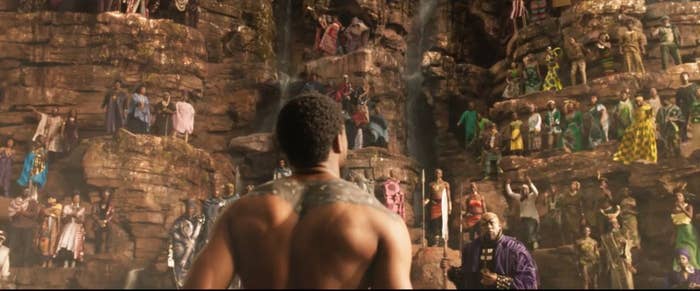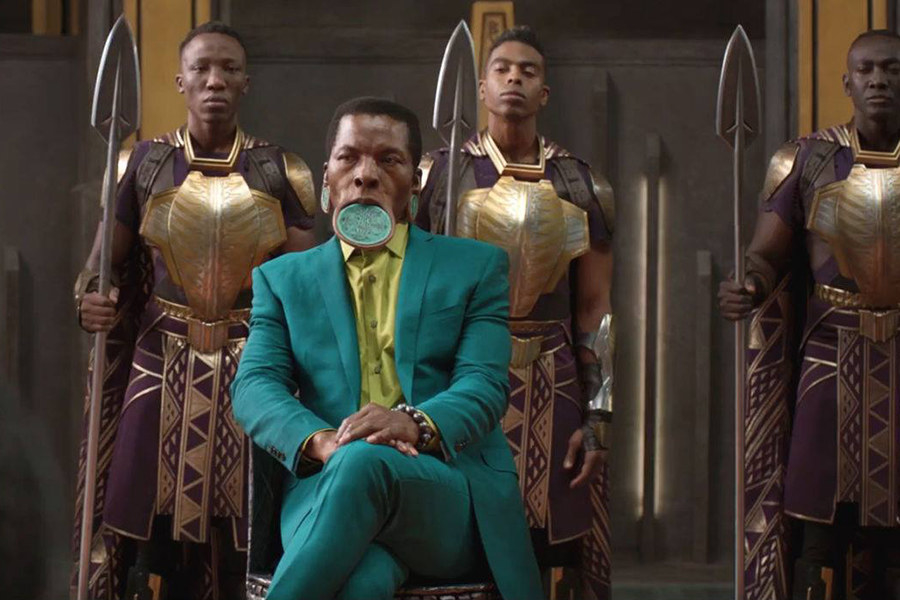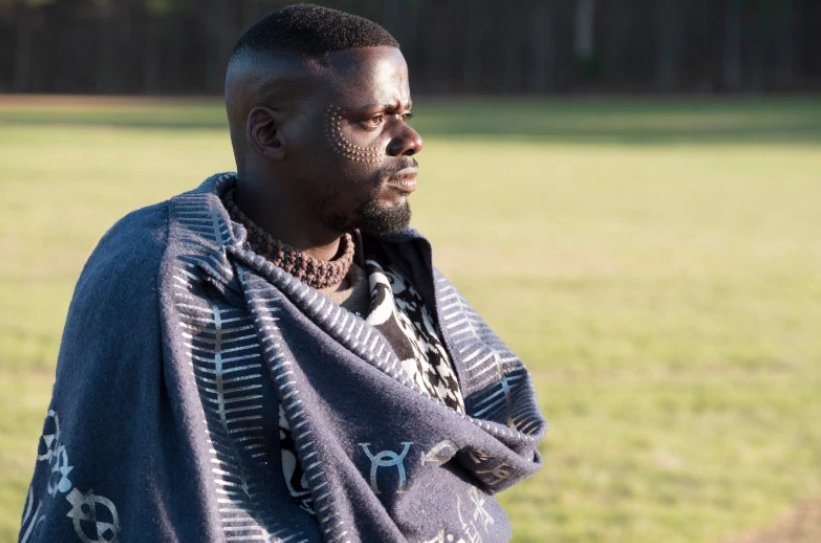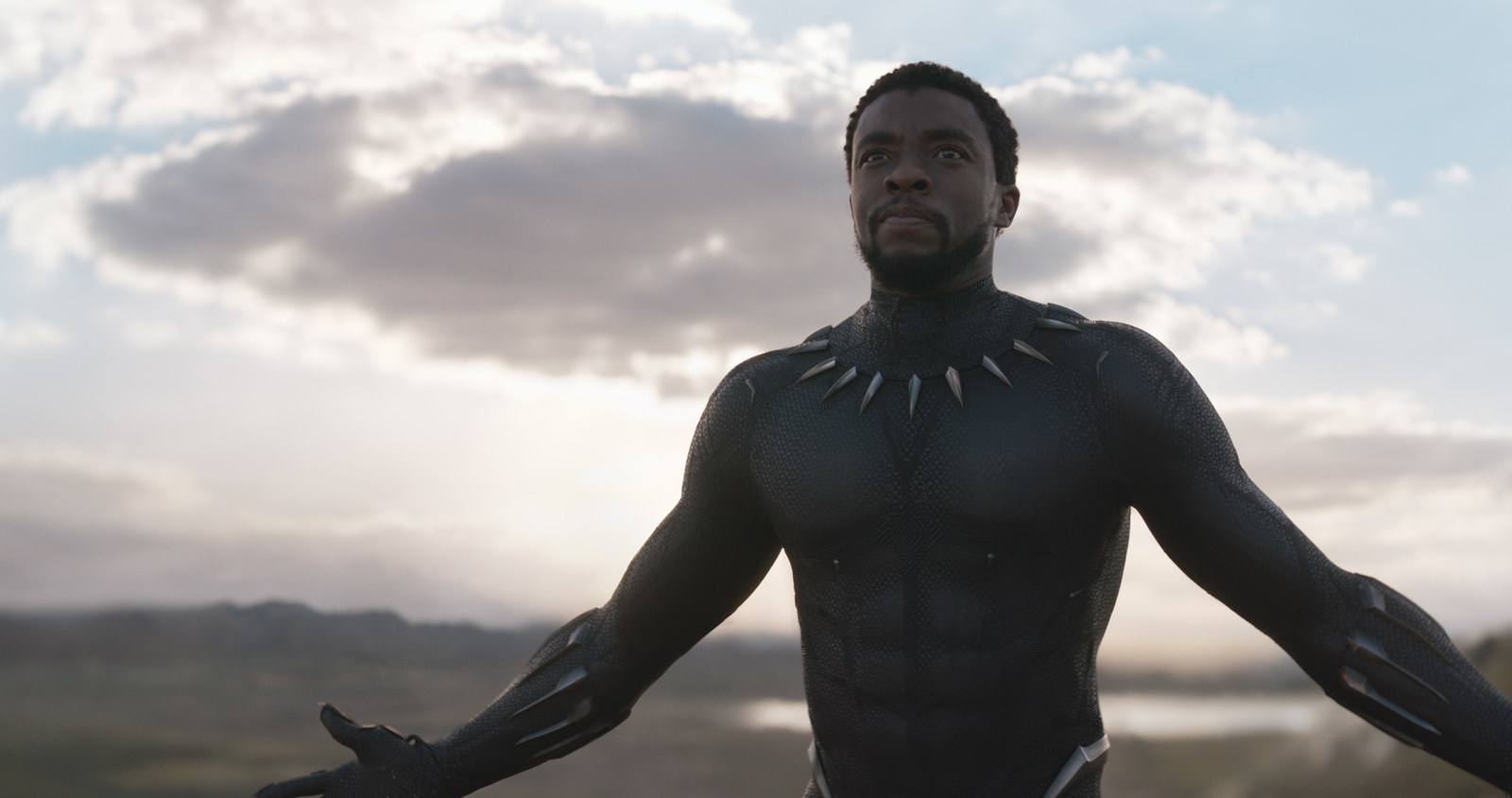
In the first act of Black Panther, Chadwick Boseman’s T’Challa has to fight for his new crown in a traditional ceremony. He does so knee-deep in a pool of water, a waterfall below and citizens of Wakanda above him, standing on a hillside. The whole image of them throbs with color and energy. As T’Challa looks up at his people, the shot is dominated by yellows, greens, blues, and pattern after pattern on their clothing. It’s a visually striking moment that has contributed to speculations that costume designer Ruth E. Carter could take home an Oscar in 2019 for her work on the film. That moment is one of many in which Black Panther brings together joy, excitement, and pride in the name of African heritage and tradition.
And it was all part of the creative team’s plan: to create a pan-African medley of real-life culture, crafty fiction, afrofuturism, and big ideas about revolutionizing black and African representation in film. The result is overwhelming, often in the best way.

Consider, for a moment, all the questions the people tasked with bringing Black Panther to the big screen had to answer. Fifty-two years after Wakanda made its first appearance in a 1966 issue of Fantastic Four, a lot was still up in the air about how the fictional African country would look, feel, and function on screen. So when director Ryan Coogler returned from a research trip to countries that included South Africa and Kenya, he sunk his teeth into creating some answers. He was accompanied by a team that included, among others, Carter and production designer Hannah Beachler. They discussed everything from Wakanda’s precise location, population, and physical size to what the topography was like and where, how, and why each Wakandan tribe lived where they did.
Speaking about those first meetings, Beachler told BuzzFeed News that “you have to answer all these questions in order to even begin to design” something like Wakanda. It was during that process that they decided that their version of the country was in sub-Saharan Africa, bordering the Democratic Republic of Congo. They knew they’d have a central district where the palace would sit, along with medical and business districts. And they knew that aesthetically they’d be pulling inspiration from afrofuturism, afropunk, and biomimetics, not to mention over 50 years of comics history and a wide selection of real-life cultures across a massive continent.
But it’s impossible to free Wakanda entirely from the painful real-life history of colonialism.
They also knew, perhaps above all, that Black Panther was in a unique and challenging position, not only as the first massive black ensemble superhero movie, but as one centered on African characters in Africa. Black Panther and Wakanda alike have long been iconic, but before 2018, the country had never been seen on screen. The fictional land itself is also filled with contradictions the team had to work with. Wakanda is isolationist, but with access to the outside world. It’s also not a real place, which frees it from certain restrictions of real-world history. But it’s impossible to free Wakanda entirely from the painful real-life history of colonialism.
“We tried to imagine an area of Africa that wasn’t colonized,” Carter told BuzzFeed News. She describes the process as “stripping something down and reimagining it in a modern society that kind of pays homage” to a variety of cultural traditions, while at the same time creating “an interesting new view of it.”
Wakanda is established in the film as a place where different tribes across the continent settled millennia ago. When colonialism began to sweep across Africa, the tribes banded together to form Wakanda as an isolationist country shielded from outside forces. Those origins gave Carter, Beachler, Coogler, and the rest of the creative team license to pull inspiration from cultures across the continent, not just those in the sub-Saharan region. It was always going to be a tricky gig, though — any media portraying African cultures has to grapple with the centuries of reductive and stereotypical portrayals that have long warped Western viewpoints of the continent. Vastly different regions in Africa are often conflated as it is. The very history of colonialism that led Wakanda’s fictional leaders to isolation makes a fictional country pulling from a wide array of those regions a harder feat to pull off.
But for the crew behind Black Panther, those elements didn’t feel like a hindrance — they felt like an opportunity. As both Carter and Beachler told BuzzFeed News, a major goal of the Black Panther team was to reframe mainstream images of African cultures. And so they set about constructing a more celebratory portrayal. Black Panther was already centered on Wakandan royalty; that provided a handy counter to the images of suffering and poverty that have long dominated black narratives in Hollywood.
“We just put pride in there.”
“I really felt strongly that this was an aesthetic that had not been examined enough, that had not been dealt with in a modern way,” Carter said of the film’s African setting. “And I think that’s why I worked well with the people that hired me, because they felt the same way. We were here to kind of present it in a royal way.”

The team worked hard to infuse Black Panther with pride for images long associated with African cultures that had historically been stigmatized in Western media. It’s what drove them to include characters with lip plates. Lip plates have been part of many cultures, including, but not limited to, the Mursi and Suri of southwestern Ethiopia, the Sara and Lobi of Chad, and the Makonde of northern Mozambique and southeastern Tanzania. In Black Panther, they are also worn by the River tribe of Wakanda. “We very much put the River tribe elder with the lip plate in a beautiful green suit in full display, and it is beautiful,” Beachler said. “No one should ever be ashamed of that. And you never see that on screen, unless it’s like somebody out in the bush, you know what I’m saying?”
While on his trip to several African countries before production began, Coogler stopped in Lesotho, the country-within-a-country bordered only by South Africa. There he fell in love with the blankets of the Basotho people and sent pictures of them back to Carter and Beachler. Vibrantly colored with bold patterns of various symbols, the blankets were introduced to the Basotho in the late 1800s when a British man gifted one to Lesotho’s King Moshoeshoe I. Coogler knew he wanted to use them in the film, so Carter put Black Panther’s own spin on them. “We imported like 200 blankets from the Lesotho village, and we lined them with vibranium,” she said, referencing the (fictional) strongest metal in the Marvel universe and the resource that powers Wakanda’s technology. “We printed it all on one side so they could use them as shields.” In the film, you can see the blankets (and their vibranium lining) on Daniel Kaluuya’s character W’Kabi and the Border tribesmen he commands. According to Beachler, they also incorporated the Basotho’s expert horsemanship into the function of the Border tribe, though in Wakanda, the horses are replaced by weaponized rhinos.

Of the overall philosophy behind the film, Beachler said, “We just put pride in there.” For her, a lot of the mission was to counteract the shame she says people have long been conditioned to feel when it comes to African heritage. “We’re taught when we have dark skin that we should be ashamed of our African heritage, that we should be ashamed that people use body modification and scarification and lip rings,” she said. “Like we should be ashamed that people walk around without shoes sometimes, ashamed of all of these things — when really we should be proud of that.”
For Beachler, who previously worked as production designer for Lemonade, Moonlight, and past Coogler films Creed and Fruitvale Station, Black Panther was another chapter in a career defined by crafting iconic portrayals of blackness onscreen. “What I see is this opportunity of understanding for people, to give humanity to things that were not given that before,” Beachler said.
One striking distinction of Black Panther’s creative team is how evident it is they approached the adaptation of this fictional African country from a largely African-American perspective. “I have descendants from Africa, but I’m not directly from Africa,” Carter said. “But [portrayals of Africa] would annoy me and infuriate me, because I felt like it’s the one place that has not been depicted properly.” Of his decision to journey to Kenya, South Africa, and Lesotho for his first trip to the continent, Coogler told Variety he knew it was his responsibility to go before directing the film. “I’m not qualified just because I look like this,” he said.
What they built is a pan-African, afrofuturistic ode to the wider notion of African heritage, diaspora and all.
That African-American perspective is visible in the end result of Black Panther, from the film’s opening scene set in Oakland and through the entire character arc of Michael B. Jordan’s Erik Killmonger. Killmonger was raised in the US but has Wakandan lineage. In Black Panther, he’s hell-bent on returning to Wakanda for reasons very tied up in the damages of colonialism and anti-black racism, with much of his mission statement fueled by the black American struggle.
That same African-American perspective shines through in Carter and Beachler’s visual approach to bringing Wakanda to the screen. They reached across the whole continent for inspiration, painting with a wide brush that shouts out to a broader African heritage with cultural roots scattered by the transatlantic slave trade — not necessarily speaking directly to any individual culture or real-life African country. There’s the Maasai beadwork, the Basotho blankets, the lip plates, the architecture inspired by ancient buildings from Timbuktu and Mali. What they built is a pan-African, afrofuturistic ode to the wider notion of African heritage, diaspora and all. And it’s all packaged in a massive superhero film that is undeniably the first of its kind.
There is a long history of Western portrayals of Africa conflating its thousands of incredibly diverse cultures, creating the false sense of Africa as a monolith. Through Black Panther, Marvel seems to have found a small loophole: Center the story on a fictional country built off the migration of tribes from all over the continent. Put it in the hands of a mostly black, already beloved creative team deeply invested in creating positive portrayals of blackness. Give them the resources and power to make something colorful, aspirational, epic in scope, and truly ambitious. Then welcome it into the world and take note of where it lands in history. If we’re lucky, this is only the beginning.

